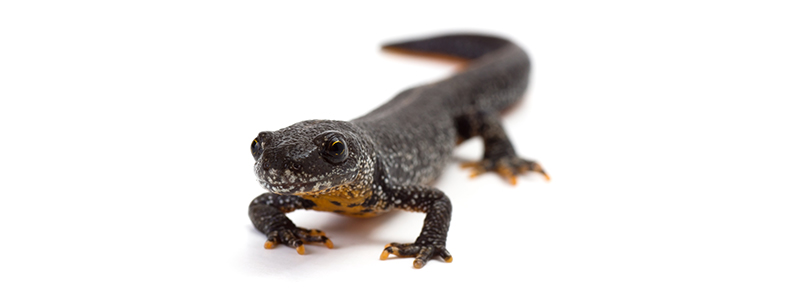The Great Crested Newt has been in decline during the last century, so we are incredibly lucky to find them, both in our waterways and in the lake, here at Grim’s Dyke.
Great Crested Newts are the largest of the UK’s three native species, growing up to 17cm in length. Their decline is, in part, due to the deterioration and loss of ponds around the UK – so we are proud that, whilst keeping the grounds and waterways of Grim’s Dyke as close to their original state to honour the late W.S. Gilbert, we can also provide a safe haven for the protected Great Crested Newt too.
Our commitment to the natural environment
Being a seclude haven of peace and quiet, Grim’s Dyke is a unique environment for animals, birds and insects. The formal gardens and adjoining woodland, orchard, moat and open fields beyond, all offer a special place to see the thriving wildlife community. If you’re looking for the Great Crested Newt along our waterways and in the lake, you’re more likely to see them during the breeding season of March to June – but please bear in mind, it’s an offence to disturb, injure, kill or capture them – and this applies to all life stages from egg to full grown.
This is, in part, due to our commitment to keep the grounds organic as much as possible, without the use of pesticides, to ensure it’s healthy for both its human and wildlife visitors. We ensure our hedges are trimmed at a time of year that will avoid disturbing the nesting birds and dead wood in the orchard is turned into log piles to encourage hibernating animals and insects. This means visitors to Grim’s Dyke get to witness Muntjack deer, foxes, voles, owls, woodpeckers and bats… and of course, not forgetting the Great Crested Newt.
We encourage visitors to spend time here, taking in both the scenery and the wildlife and we’ve installed a number of sign posts to ensure you can safely explore the acres of grounds around the hotel. We want you to make the most of what is naturally provided here at Grim’s Dyke – making it a perfect place to visit for those who love nature and its resident animals.
How can you tell you’ve spotted a Great Crested Newt?
With three different species of newt in the UK, you’ll want to ensure you correctly identify the Great Crested Newt, so here’s a few pointers to help:
- It’s significantly larger than the others, growing to 17cm in length
- It’s ‘warty’ skin is either dark brown or black in colour
- The underside of the Great Crested Newt is bright orange, with irregular black blotches
- In spring, the males have a jagged crest along their back and a white flash on their tail
- Great Crested larvae are mottled with black spots and have a fine filament at the end of the tail
Lady Lucy & Sir William Gilbert’s Legacy
Both Sir William and Lady Lucy were keen gardeners and keen animal and nature lovers – and this was illustrated by the lively menagerie of animals that resided at Grim’s Dyke! The property and grounds were always home to all types and species – from donkey and dog, right down to lemurs and bumble bees – their love of all, clear to see. I’m sure they’d both have been honoured to know that their legacy lives on today and is still providing a safe haven for the Great Crested Newt.


